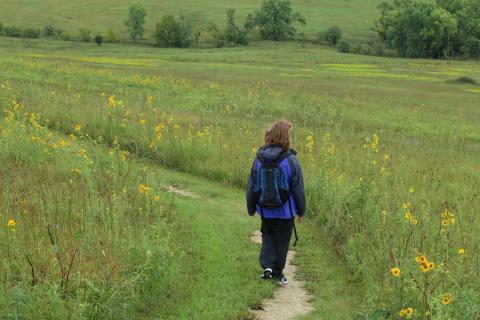A light drizzle created a gray sky when my mom and I hopped out of the car at the Tallgrass Prairie National Preserve in Kansas. The flint hills rolled all around us, differing shades of green fading in and out of the distance. Though the prairie used to cover 170 million acres, only 4 percent still exists, 11,000 acres of which are within the preserve.
Mom and I had a goal: to see as many bird species as possible as we explored the trail system. After retrieving a map and a passport stamp from the visitor center, we hiked up behind the historic home and farm on the property and literally “headed for the hills.”
Flowers surrounded us as we scaled one hill and went down the side of another, goldenrod and so many others I couldn’t identify waving in the breeze. Normally the grasses would be higher in September, but a horrible drought had plagued Kansas that summer, keeping all vegetation lower than usual. We spotted a Great Blue Heron hunting in a small pond, a Ruby-throated Hummingbird zipping between the flower stalks while Eastern Bluebirds and American Goldfinches searched for seeds.
Following the trail, we wound our way down to the river at the bottom of the hills, surrounded by hardwood trees and dense shrubberies. A smattering of songbird calls stopped us in our tracks, and we whipped out our cameras to take as many images of the species we didn’t recognize as possible. A brightly colored Kentucky Warbler hopped out on a lone branch, then disappeared, followed by a Bell’s Vireo. A chipper Bewick’s Wren ran along a downed log, while a gaudy orange Baltimore Oriole was just barely visible behind bright green leaves of the canopy.
We walked up to an old schoolhouse, looking out over the road that now leads to the national preserve. What did it feel like to go to this old building, alone on the top of a windy hill?
As we turned and started back towards the visitor center parking lot, we spied a handful of black shapes on the horizon line lumbering slowly away from us. Bison!
Bison were once a critical part of the prairie ecosystem, their grazing creating important biodiversity changes to the grassland. In 2009, the National Park Service and The Nature Conservancy brought 13 bison to the Tallgrass Prairie from Wind Cave National Park - today, the herd numbers nearly 90 animals. The bison are continually monitored to make sure the small bison population in Tallgrass do not inbreed with each other.
Two hours after we began hiking, and over two miles later, we had spotted 24 species of birds including four I had never seen before (thus new to my Life List). Protected prairies are critical to preserving these grassland-dependent species, including bison, for future generations.




Add comment